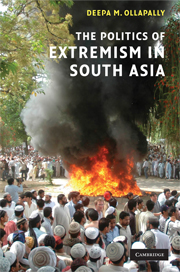Book contents
- Frontmatter
- Contents
- Acknowledgements
- Map of South Asia
- 1 Introduction: beyond and before the 9/11 framework
- 2 Situating violent conflict in South Asia
- 3 Afghanistan's changing fortunes
- 4 Pakistan at the crossroads
- 5 Conflict and contradiction in Kashmir
- 6 Sri Lanka's violent spiral
- 7 Bangladesh: divided politics and geopolitics
- 8 Conclusion
- Bibliography
- Index
3 - Afghanistan's changing fortunes
Published online by Cambridge University Press: 05 September 2012
- Frontmatter
- Contents
- Acknowledgements
- Map of South Asia
- 1 Introduction: beyond and before the 9/11 framework
- 2 Situating violent conflict in South Asia
- 3 Afghanistan's changing fortunes
- 4 Pakistan at the crossroads
- 5 Conflict and contradiction in Kashmir
- 6 Sri Lanka's violent spiral
- 7 Bangladesh: divided politics and geopolitics
- 8 Conclusion
- Bibliography
- Index
Summary
After September 11, Afghanistan became almost synonymous in the popular mind with terrorism and religious extremism. The image of a wild ungovernable region shot through with warlordism and ethnic warfare became established and, along with it, an underlying assumption that such a state of affairs had been a historical inevitability. The curious absence of any Afghans among the 19 suspected hijackers of September 11 went unnoticed by most commentators. With the fall of the Taliban and the rise of Hamid Karzai's government, however, there is now a new image of an Afghanistan transformed into a “success story,” thanks to international intervention.
Neither perception – of the historical inevitability of the preceding violence or of a country about to be saved from itself – is wholly accurate. Much like its neighbors in South Asia, the Afghan identity is made up of diverging secular, religious and geopolitical identities. To understand the rise of extremism in Afghanistan and forecast its future, it is necessary to see how these different tendencies have interacted to produce religious militancy and the excesses of the Taliban and beyond. The US invasion of Afghanistan in October 2001 turned the spotlight on the key political and military actors in Afghanistan who had long been shielded from international sight: first during the covert anti-Soviet war; then through the dizzying civil wars; and finally under the Taliban's self-inflicted isolation.
- Type
- Chapter
- Information
- The Politics of Extremism in South Asia , pp. 53 - 83Publisher: Cambridge University PressPrint publication year: 2008



